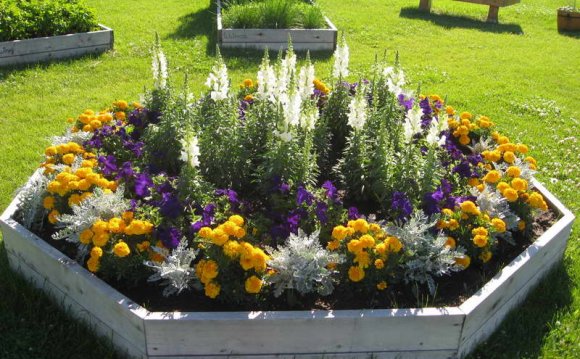
Perennials return each year to provide splashes of color and texture to garden beds and borders. Here are some basic garden layout tips and techniques used by professional garden designers that you can easily apply in your own garden:
The most common way to display perennials is together, in a large flowerbed or, space permitting, a long border of either meandering form or with firm boundaries. These methods of growing perennials are purely practical: You can prepare the soil, plant them together, and care for them.
- Plan to be in scale: Some sense of proportion between your home, garage, and/or shed (whatever’s nearest to the proposed perennial garden) is key. A big house, for instance, does best with wider beds and taller plants; a smaller one is better served by a series of smaller beds and lower-growing plants.
- Match garden style with structures: A casual bungalow, cottage, or one-level home likes an informal perennial garden, with wavy-edged boundaries; a larger or more imposing home, or one with strong architectural elements and lines, needs a more formal, straighter-edged approach.
- Try a dress rehearsal: Lay out the lines of your proposed garden in advance with a hose, outdoor electrical cord, rope, or even chalk or flour. Set potted plants or lawn chairs or whatever here and there within its bounds as stand-ins (these items should match the perennials in terms of mature height and bulk, not the size of the plants you buy); stand back and assess. Tinker with the plan until you’re satisfied, and then sketch it on paper so you can remember it on planting day.
After you have your layout planned, you’re ready to begin your plant selection. In addition to choosing plants for the bloom times and colors, take these points into consideration when choosing your plants:
- Consider height and width: Perennial gardeners have to be patient and be able to imagine the future because new plants are small. Find out your chosen plants’ expected mature sizes and allow them enough elbow room in your plan. Plan to position taller-growing plants to the back of a traditional border or the center of an island bed; array lower growers at their feet. If you need help visualizing, some software programs let you see what your garden will look like as plants mature.
- Mix it up: Nature loves diversity, and the variety looks great — it keeps the eye moving even as it lets individual plants stand out. So intersperse a variety of plant forms, from spiky ones to mound-formers.
- Match the plant to the growing conditions: Save yourself a lot of grief and wasted money and effort by choosing plants that are clearly labeled as sun-lovers or shade-lovers, as the case may be in your intended site.
Source: www.dummies.com















